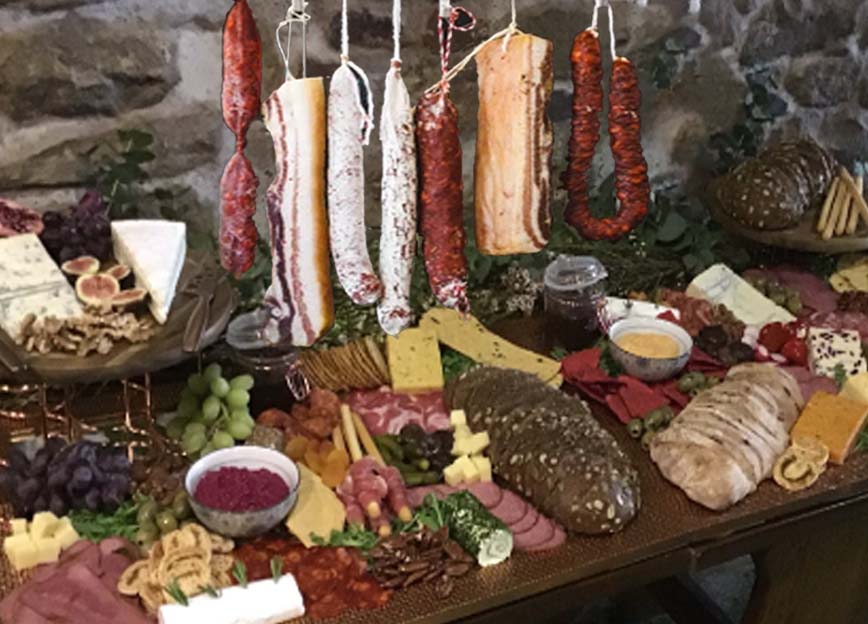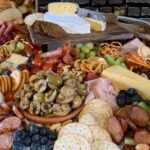We love hosting and entertaining. We want to know all things about it. We can’t get enough of it. Charcuterie boards have become a staple at many gatherings and for good reason. These boards are filled with an array of meats, cheeses, crackers, fruits, and nuts making them a perfect way to entertain guests and satisfy hunger at the same time. But where did the idea for these boards come from? How have they evolved over time?
In the beginning…
The origins of charcuterie boards can be traced back to ancient Rome, where meats were salted and smoked to preserve them. This process removed all moisture and made it an inhospitable environment for bacteria. The dry meats were a common food for peasants, laborers and soldiers, who ate them with bread, and pickled vegetables. As the art was perfected and the quality of meats improved, it gained popularity with the upper class and highborn.
While using salt to cure meats dates back to the Roman empire, it was the French who pioneered the modern versions in the 15th century and henceforth labeled it Charcuterie, which comes from the French word “chair” meaning Flesh and “cuite,” meaning “cooked,” which refers to the art of preparing and preserving meats. The later Charcutiers were skilled artisans who specialized in creating a variety of meats, such as sausages, pâtés, and cured hams. These meats were often sold in shops called charcuteries, which were found throughout France. Charcuterie was a way of preserving meat before refrigeration. It became and has remained a way of enjoying bits and bites of a variety of flavors at one gathering.
More Recent Modifications…
As French cuisine gained popularity throughout Europe and North America, charcuterie boards became a fashionable way to entertain guests. It wasn’t until the 19th century that charcuterie boards became popular. These boards were now a staple to gathering of family, friends and guests. In France, these boards were called “assiette de charcuterie,” which translates to “plate of cooked meats.”
As the popularity of charcuterie boards grew, so did the demand for a wider variety of meats and cheeses to include on these boards. Artisanal cured meats became more widely available, as did specialty cheeses from around the world. This led to a trend of creating charcuterie boards that featured a diverse selection of flavors, textures, and colors. Over time, the practice of serving charcuterie evolved, and the boards themselves became a form of modern entertainment but many of the techniques used in traditional charcuterie are still in use today.
The aesthetics of the charcuterie board also became an important consideration, with boards being arranged in more elaborate and decorative visually appealing ways to showcase the different meats and cheeses. The use of garnishes like herbs, olives, and pickles also became common, adding a pop of color and flavor to the board.
In addition to the visual appeal, the convenience factor also played a role in the rise of charcuterie boards as a popular entertaining option. In the 1960s and 70s, there was a shift from sit down dinners and cocktail parties became all the rage, and charcuterie boards were a popular way to serve hors d’oeuvres. These boards were often made to nosh on as guests moved about in a less formal and more social setting. This makes them an ideal choice for events where guests may be arriving at different times or where there may not be enough seating for a sit-down meal.
And Still Yet Today…
In recent years, charcuterie boards have experienced a resurgence in popularity, thanks in part to social media. Instagram and Pinterest are filled with photos of elaborate charcuterie boards, featuring an array of meats, cheeses, fruits, and nuts. Today, these boards are often seen at business board meetings, small social gatherings, weddings, baby showers, memorials, and other events, and are a favorite among foodies and home entertainers alike. Boards have become a great gift option as well for Birthdays, Mother’s/Father’s Day, Major Holidays and even as tokens of appreciation.
While their appearance and contents may have changed, the traditional techniques used to make the meats and cheeses have remained largely the same, creating a delicious blend of old and new in every bite. Despite the modernization of the charcuterie board, many traditional techniques are still used today. Artisans still use natural casings and rely on the quality of the meat and the skill of the butcher to create the perfect product. The same can be said for cheese-making techniques, which have been passed down through generations.
While the history of charcuterie boards reflects the evolution of entertaining styles over time, from their humble beginnings as simple plates of cooked meats in France, they have evolved into elaborate displays perfect for modern-day entertaining. These boards are a perfect way to bring people together. Whether you’re looking to entertain guests or simply enjoy a tasty snack, a charcuterie board is sure to satisfy. So next time you’re hosting a gathering, from picnic to party, why not call us to do all the work and prep, set up and create that beautiful board all together for you and impress your guests as you enjoy the event.

